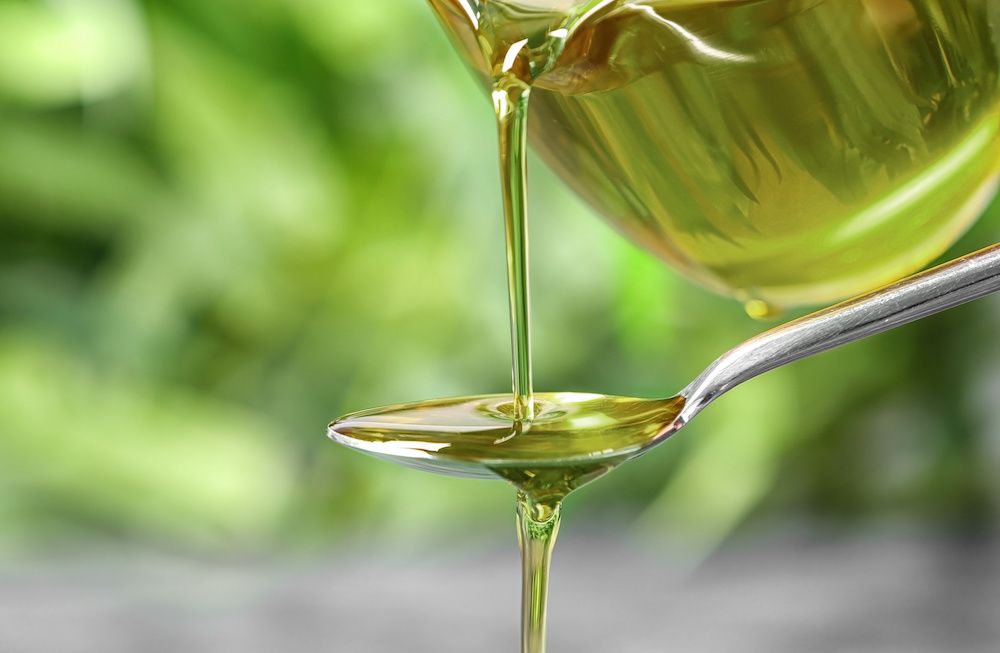Easy Cannabis-Infused Oil Recipe
Cannabis-infused oil is a staple of cooking with the plant. This article shows you an easy, step-by-step way to make any cannabis-infused oil at home!

We’ve explained the basics of cooking with cannabis, and showed you how to pick the best cultivar for your tastes. This article shows you an easy, step-by-step way to make any kind of cannabis-infused oil from home!
Before we get into the meat and potatoes of how to make canna-oil, there are three crucial things we need to reiterate about cooking with cannabis from home. These are all areas we’ve discussed before in other articles, and you can read more in-depth in the guides and cannabis 101 sections of our blog. You can also check out our previous articles on how to pick the best cultivar for cooking, as well as some of the best cannabis cookbooks for 2021.
Just a Little Patience
As is the case with all cooking, patience is a virtue, and practice makes perfect. We’ll spare you any further platitudes or adages, but it’s highly important to note whenever we’re talking about home cooking with cannabis. Learning what you want and the right dose for you involves trial and error, experimentation, and learning. We recommend leaving about 12 hours at home where you don’t have any pressing commitments to attend to, and please don’t ever drive when consuming cannabis.
You likely won’t make your favorite, perfectly dosed cannabis-infused dish that appeals to your taste buds with the first or second try. That’s okay - and part of the fun of cooking at home! If you lose your patience, you can always check out some edibles at a dispensary, but we think the meals we cook ourselves taste better anyway.
Increased Potency
When it comes to safely ingesting edibles as opposed to other consumption methods, one of the most important things to remember is the increased potency. Ingesting cannabis also has a delayed onset of effects compared to smoking or vaping. This delayed onset is the main reason why inexperienced consumers will end up ingesting too much. They don’t feel anything after an hour, so they take more - and then when the effects set it, it’s too much. Again, patience and research can help prevent this from happening to you.
Don’t Forget to Decarb!
Last but most certainly not least, do not forget or neglect the crucial process of decarboxylation. >"Decarboxylation means using heat or solvents to convert the cannabinoids into their active and most beneficial forms." Decarboxylation means using heat or solvents to convert the cannabinoids into their active and most beneficial forms. While raw cannabis, either fresh or dried has beneficial health properties of its own, decarbing your cannabis before cooking unlocks the true potential of cannabinoids. Check out our cooking with cannabis from home 101 article for the quickest and easiest way to decarb properly in your own kitchen.
While you can skip the decarb step, as it will just add longer cooking time in most cases, we recommend getting in the habit of decarbing - it makes everything run more smoothly, we think. Just be sure to keep your cannabis under around 300 degrees, otherwise, you run the risk of denaturing the compounds found in cannabis. We recommend purchasing and using a digital thermometer to keep your cannabis-infused kitchen creations at the right temperature.
With those three important aspects in mind, let’s get into our recipe on how to make cannabis-infused cooking oil.

How To Make Cannabis-Infused Oil
Aside from cannabutter, infusing oil with cannabis is one of the most common ways to eat edibles. For many canna-chefs, it’s the holy grail and the baseline of getting started cooking with the plant. You can use your oil for anything you’d use cooking oil for - with that cannabinoid infusion, of course. We most typically cook with cannabis-infused coconut oil. You can use less or more ingredients than what we’ve listed here, but here’s the easiest way we know to make canna-oil at home:
You’ll Need:
- Medium-Sized Pan
- Cheese Cloth (or another straining method)
- Baking Sheet
- Wooden Spoon
- Aluminum Foil
- An Ounce of Dried Cannabis Flower
- 16 Ounces Unrefined Coconut Oil
- Storage Container for Finished Oil (we recommend mason jars)
7 Easy Steps:
- Melt the coconut oil in a medium-size pan over low heat. Preheat your oven to 215°F.
- Next, pour your melted oil over your decarbed cannabis flower. Use your wooden spoon to mix everything well. The goal is to coat everything and mix it all together.
- Place the oil-coated cannabis on your baking sheet. Cover it tightly with aluminum foil and put it in your preheated oven.
- Bake for about 90 minutes, depending on your oven, ingredients, and so on. Stir the mixture every 30 minutes while cooking to ensure that your cannabinoids and flavinoids are evenly distributed.
- Take the pan out of the oven, and let it cool for 15 minutes with the aluminum foil still covered. Allow everything to rest until it’s relatively cool to the touch.
- Put two layers of cheesecloth over your mason jars. Pour your infused oil over the cheesecloth and strain out all large bits of plant matter. Do it carefully, and try not to spill anything.
- Grab both sides of your cheesecloth and squeeze out any residual oil. That’s it! You’re ready to enjoy!
After straining the cannabis plant matter from your oil, you’re left with a ball of cannabis that some enthusiasts call pulp. This ball of pulp is devoid of most cannabinoids at this point, but you can add it to other recipes for the flavor. After all, why waste it? Let us know if you’d like to see some content of what to do with your pulp.
Your oil will last at solid potency for up to three months, depending on what kind of cannabis you used in the first place. However, we recommend consuming your cannabis-infused oil within a month - otherwise, you run the risk of degrading the potency of THC, defeating the purpose of all of that work!
Cannabis Cooking - A Journey, Not a Destination
The joy of cooking is experimenting in the kitchen, learning what you like best and what cannabinoid combos work for you. It’s a process that requires patience that some home-cooks just don’t have.
For more cooking ideas, you might also want to check out our healthy alternatives to cannabutter article.
HashDash - Education and Community for Cannabis Consumers
Did you find value in our content about how to infuse cooking oil with cannabis? Did you learn something? Let us know - @hashdash on all platforms, except for Instagram, where we are @hashdashdotcom.
We’re planning on producing much more cooking-related content, so be sure to check back on our blog often. We post fresh content every single week!
HashDash is building a vast knowledge database of helpful articles and ways to enhance the cannabis consumption experience. Don’t forget to sign up for HashDash to discover your cannabis matches.
Thanks for reading! As always, please consume cannabis responsibly!
